heater PONTIAC GRAND-AM 1995 Owners Manual
[x] Cancel search | Manufacturer: PONTIAC, Model Year: 1995, Model line: GRAND-AM, Model: PONTIAC GRAND-AM 1995Pages: 354, PDF Size: 17.81 MB
Page 71 of 354
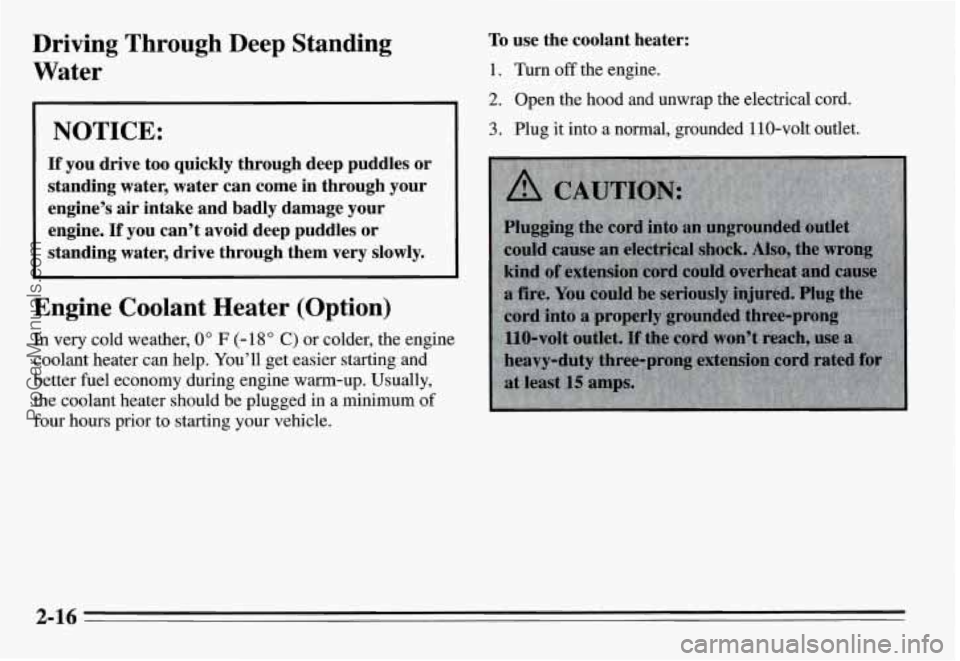
Driving Through Deep Standing Water To use the coolant heater:
1. Turn off the engine.
2. Open the hood and unwrap the electrical cord.
NOTICE: 3. Plug it into a normal, grounded 110-volt outlet.
If you drive too quickly through deep puddles or
standing water, water can come in through your
engine's air intake and badly damage your engine.
If you can't avoid deep puddles or
standing water, drive through them very slowly.
Engine Coolant Heater (Option)
In very cold weather, 0" F (- 18 O C) or colder, the engine
coolant heater can help. You'll get easier starting and
better fuel economy during engine warm-up. Usually,
the coolant heater should be plugged in a minimum of
four hours prior to starting your vehicle.
2-16
ProCarManuals.com
Page 72 of 354
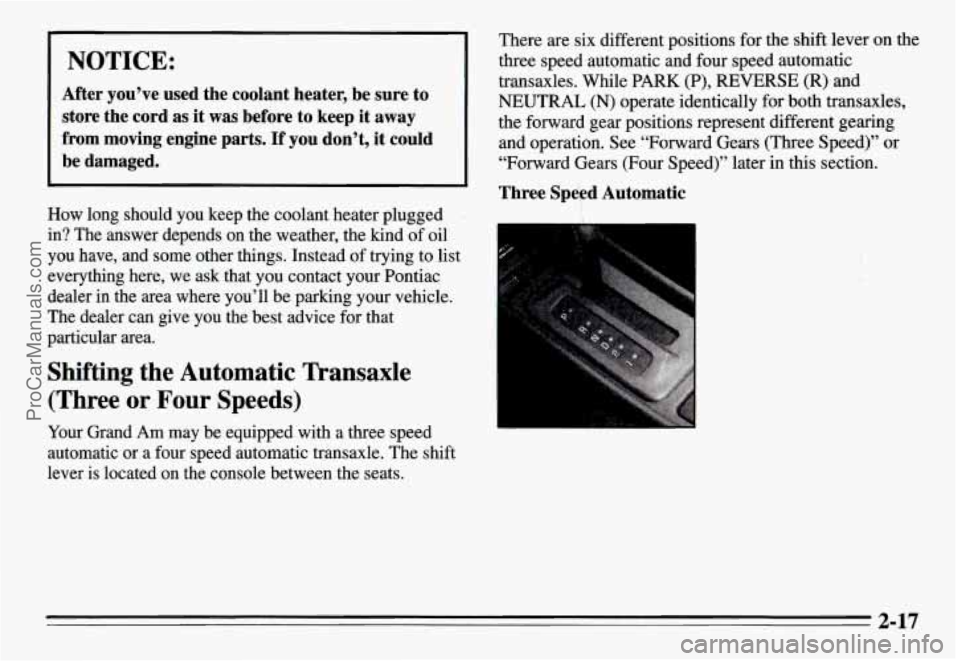
I NOTICE: I
After you’ve used the coolant heater, be sure to
store the cord as it was before to keep it away
from moving engine parts.
If you don’t, it could
be damaged.
How long should you keep the coolant heater plugged
in? The answer depends on the weather, the kind of oil
you have, and some other things. Instead of trying to list
everything here, we ask that you contact your Pontiac
dealer
in the area where you’ll be parking your vehicle.
The dealer can give you the best advice for that
particular area.
Shifting the Automatic Transaxle
(Three or Four Speeds)
Your Grand Am may be equipped with a three speed
automatic or a four speed automatic transaxle. The shift
lever
is located on the console between the seats.
There are six different positions for the shift lever on the
three speed automatic and four speed automatic
transaxles. While
PARK (P), REVERSE (R) and
NEUTRAL (N) operate identically for both transaxles,
the forward gear positions represent different gearing
and operation. See “Forward Gears (Three Speed)” or
“Forward Gears (Four Speed)’’ later in this section.
Three SpeFd Automatic
1.
.. . ..b
2-17
ProCarManuals.com
Page 124 of 354
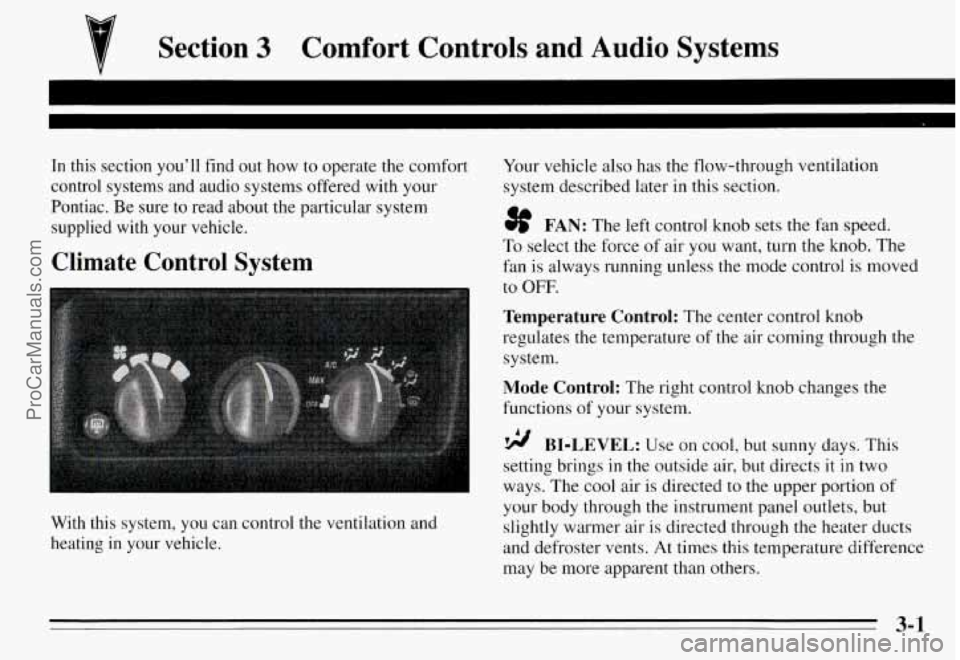
Section 3 Comfort Controls and Audio Systems
In this section you’ll find out how to operate the comfort
control systems and audio systems offered with your
Pontiac. Be sure to read about the particular system
supplied with your vehicle.
Climate Control System
With this system, you can control the ventilation and
heating in your vehicle.
Your vehicle also has the flow-through ventilation
system described later in this section.
3f FAN: The left control knob sets the Fan speed.
To select the force of air you want, turn the knob. The
fan
is always running unless the mode control is moved
to OFF.
Temperature Control: The center control knob
regulates the temperature of the air coming through the
system.
Mode Control: The right control knob changes the
functions
of your system.
BI-LEVEL: Use on cool, but sunny days. This
setting brings
in the outside air, but directs it in two
ways. The cool air is directed to the upper portion of
your body through the instrument panel outlets, but
slightly warmer air is directed through the heater ducts
and defroster vents.
At times this temperature difference
may be more apparent than others.
3-1
ProCarManuals.com
Page 125 of 354
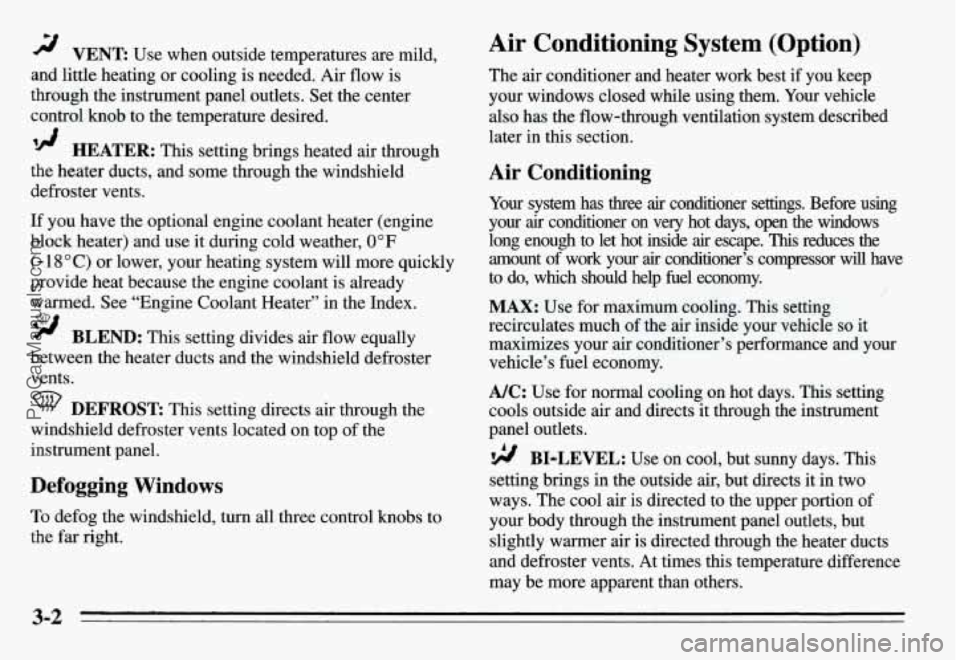
VENT Use when outside temperatures are mild,
and little heating or cooling is needed. Air flow is
through the instrument panel outlets. Set the center
control knob to the temperature desired.
HEATER: This setting brings heated air through
the heater ducts, and some through the windshield
defroster vents.
If you have the optional engine coolant heater (engine
block heater) and use it during cold weather,
0°F
(- 18 “C) or lower, your heating system will more quickly
provide heat because the engine coolant is already
warmed. See “Engine Coolant Heater” in the Index.
9 BLEND: This setting divides air flow equally
between the heater ducts and the windshield defroster
vents.
DEFROST This setting directs air through the
windshield defroster vents located on top of the
instrument panel.
Defogging Windows
To defog the windshield, turn all three control knobs to
the
far right.
Air Conditioning System (Option)
The air conditioner and heater work best if you keep
your windows closed while using them. Your vehicle
also has the flow-through ventilation system described
later in this section.
Air Conditioning
Your system has three air conditioner settings. Before using
your
air conditioner on very hot days, open the windows
long enough to let hot inside
air escape. This reduces the
amount
of work your air conditioner’s compressor will have
to do, which should help fuel economy.
MAX: Use for maximum cooling. This setting
recirculates much of the air inside your vehicle
so it
maximizes your air conditioner’s performance and your
vehicle’s fuel economy.
A/C: Use for normal cooling on hot days. This setting
cools outside air and directs it through the instrument
panel outlets.
BI-LEVEL: Use on cool, but sunny days. This
setting brings in the outside air, but directs it in two
ways. The cool air is directed to the upper portion
of
your body through the instrument panel outlets, but
slightly warmer air is directed through the heater ducts
and defroster vents. At times this temperature difference
may be more apparent than others.
ProCarManuals.com
Page 126 of 354
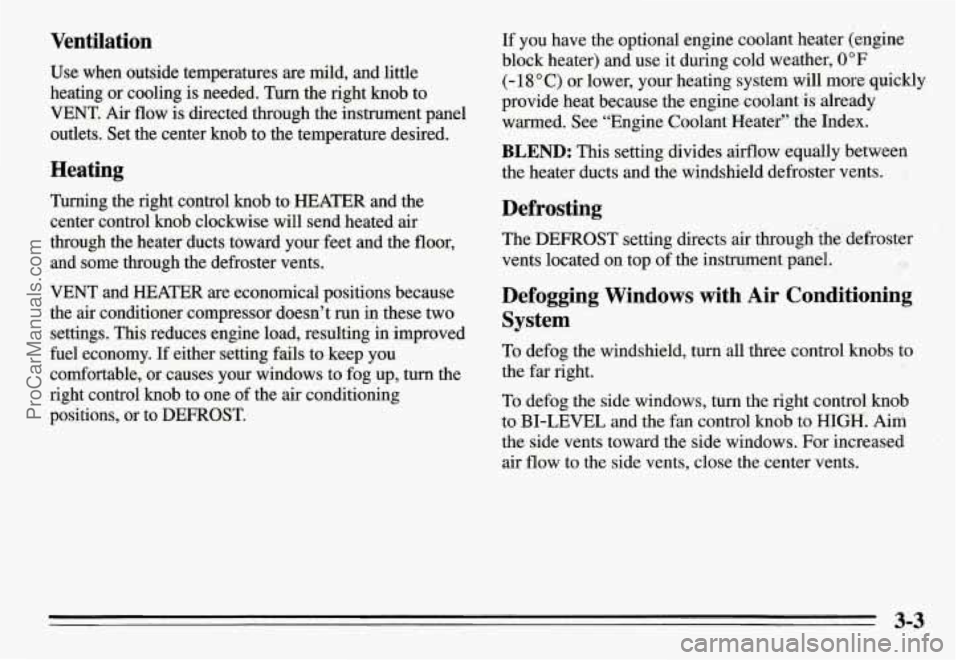
Ventilation
Use when outside temperatures are mild, and little
heating or cooling is needed.
Turn the right knob to
VENT. Air
flow is directed through the instrument panel
outlets. Set the center knob to the temperature desired.
Heating
Turning the right control knob to HEATER and the
center control knob clockwise will send heated air
through the heater ducts toward your feet and the
floor,
and some through the defroster vents.
VENT and HEATER are economical positions because
the air conditioner compressor doesn’t run in these two
settings. This reduces engine load, resulting in improved
fuel economy. If either setting fails to keep you
comfortable, or causes your windows to fog up, turn the
right control
knob to one of the air conditioning
positions, or to DEFROST.
If you have the optional engine coolant heater (engine
block heater) and use it during cold weather,
0°F
(- 18 O C) or lower, your heating system will more quickly
provide heat because the engine coolant ‘is already
warmed. See “Engine Coolant Heater” the Index.
BLEND: This setting divides airflow equally between
the heater ducts and the windshield defroster vents.
Defrosting
The DEFROST setting directs air through ‘the defroster
vents located on top of the instrument panel.
Defogging Windows with Air Conditioning
System
To defog the windshield, turn all three control knobs to
the far right.
To defog the side windows, turn the right control knob
to BI-LEVEL and the fan control
knob to HIGH. Aim
the side vents toward the side windows. For increased
air flow to the side vents, close the center vents.
22
ProCarManuals.com
Page 127 of 354
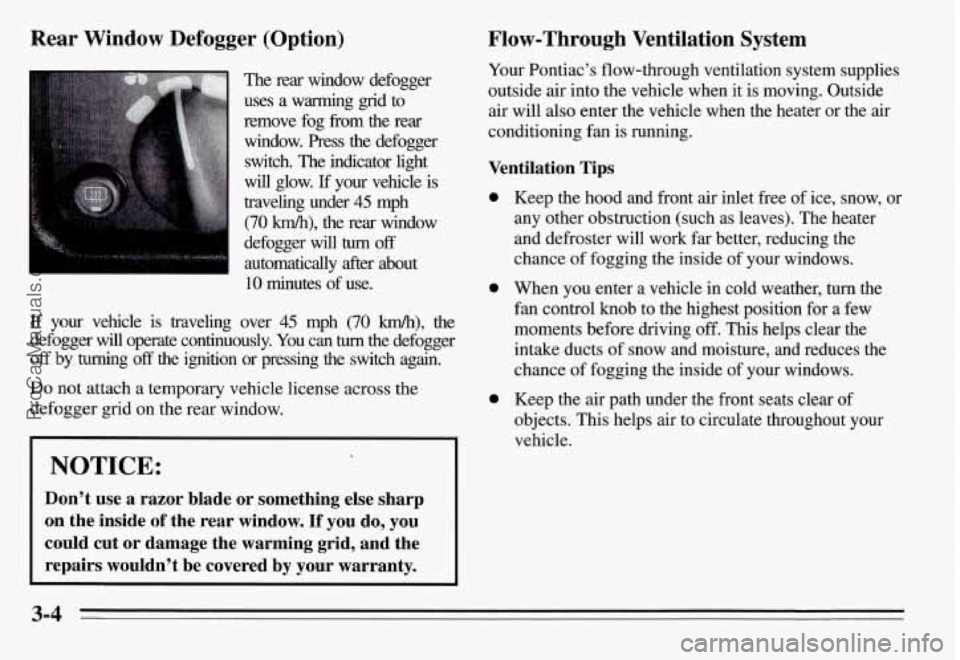
Rear Window Defogger (Option)
The rear window defogger
uses a warming grid to
remove fog from the rear
window.
Press the defogger
switch. The indicator light
will glow. If your vehicle is
traveling under
45 mph
(70 km/h), the rear window
defogger will
turn off
automatically after about
10 minutes of use.
If your vehicle is traveling over 45 mph (70 km/h), the
defogger will operate continuously. You can
h’rm the defogger
off by turning off the ignition or pressing the switch again.
Do not attach a temporary vehicle license across the
defogger grid on the rear window.
I NOTICE:
Don’t use a razor blade or something else sharp
on the inside
of the rear window. If you do, you
could cut or damage the warming grid, and the
repairs wouldn’t be covered by your warranty.
Flow-Through Ventilation System
Your Pontiac’s flow-through ventilation system supplies
outside air into the vehicle when it
is moving. Outside
air will also enter the vehicle when the heater or the air
conditioning fan
is running.
Ventilation Tips
0
0
0
Keep the hood and front air inlet free of ice, snow, or
any other obstruction (such as leaves). The heater
and defroster will work far better, reducing the
chance of fogging the inside of your windows.
When you enter a vehicle in cold weather, turn the
fan control
knob to the highest position for a few
moments before driving
off. This helps clear the
intake ducts of
snow and moisture, and reduces the
chance of fogging the inside of your windows.
Keep the air path under the front seats clear of
objects. This helps air to circulate throughout your
vehicle.
3-4
ProCarManuals.com
Page 168 of 354
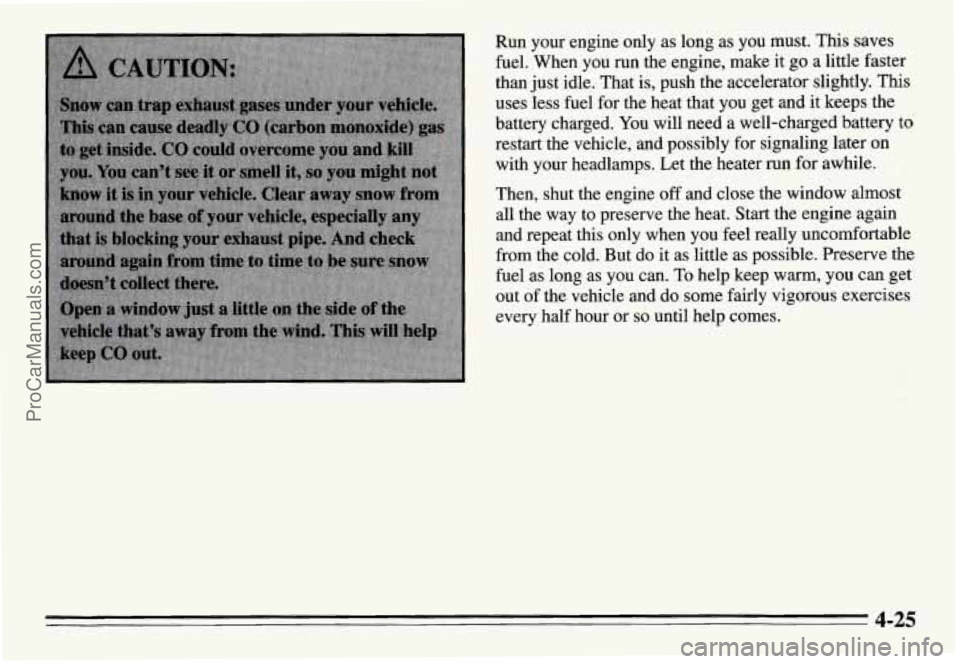
Run your engine only as long as you must, This saves
fuel. When you run the engine, make it
go a little faster
than just idle. That is, push the accelerator slightly.
This
uses less fuel for the heat that you get and it keeps the
battery charged. You will need a well-charged battery to
restart the vehicle, and possibly for signaling later on
with your headlamps. Let the heater run for awhile.
Then, shut the engine off and close the window almost
all the way to preserve the heat. Start the engine again
and repeat this only when you feel really uncomfortable
horn the cold. But do it as little as possible. Preserve the
fuel as long as you can.
To help keep warm, you can get
out of the vehicle and do some fairly vigorous exercises
every half hour or
so until help comes. J
4-25
ProCarManuals.com
Page 194 of 354
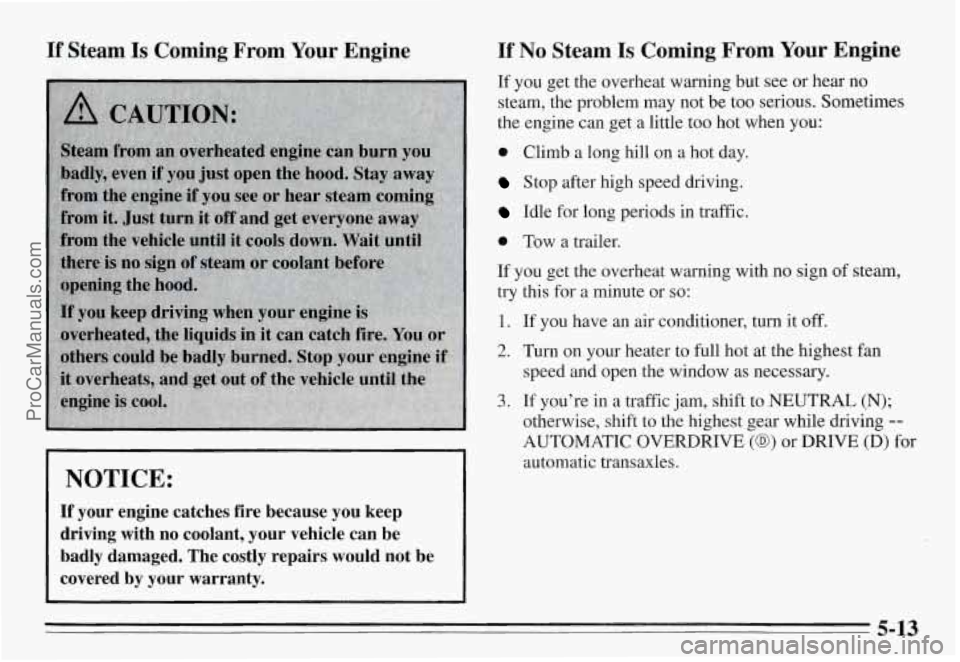
If Steam Is Coming From Your Engine
NOTICE:
If your engine catches fire because you keep
driving with no coolant, your vehicle can be
badly damaged. The costly repairs would not be
covered by your warranty.
If No Steam Is Coming From Your Engine
If you get the overheat warning but see or hear no
steam, the problem may not be too serious. Sometimes
the engine can get a little too hot when you:
@ Climb a long hill on a hot day.
Stop after high speed driving.
Idle for long periods in traffic.
@ Tow a trailer.
If you get the overheat warning with no sign of steam,
try this for a minute or so:
1. If you have an air conditioner, turn it off.
2. Turn on your heater to full hot at the highest fan
3. If you’re in a traffic jam, shift to NEUTRAL (N);
speed and open the window as necessary.
otherwise, shift to the highest gear while driving --
AUTOMATIC OVERDRIVE (GB) or DRIVE (D) for
automatic transaxles.
5-13
ProCarManuals.com
Page 196 of 354
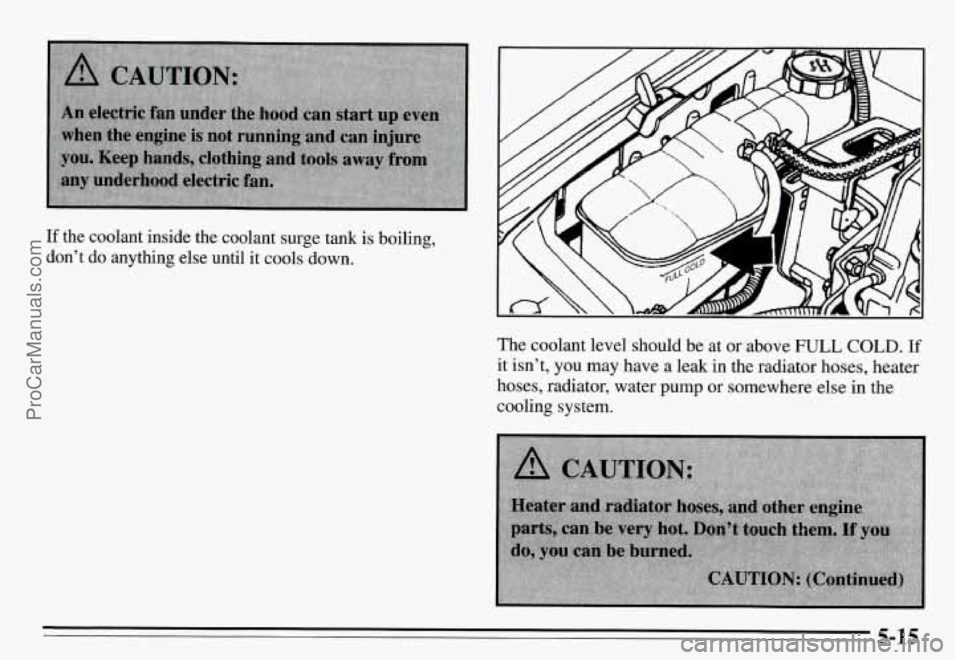
If the coolant inside the coolant surge tank is boiling,
don’t
do anything else until it cools down. 1
The coolant level should be at or above FULL COLD. If
it isn’t, you may have a leak in the radiator hoses, heater
hoses, radiator, water pump or somewhere else in the
cooling system.
5-15
ProCarManuals.com
Page 199 of 354
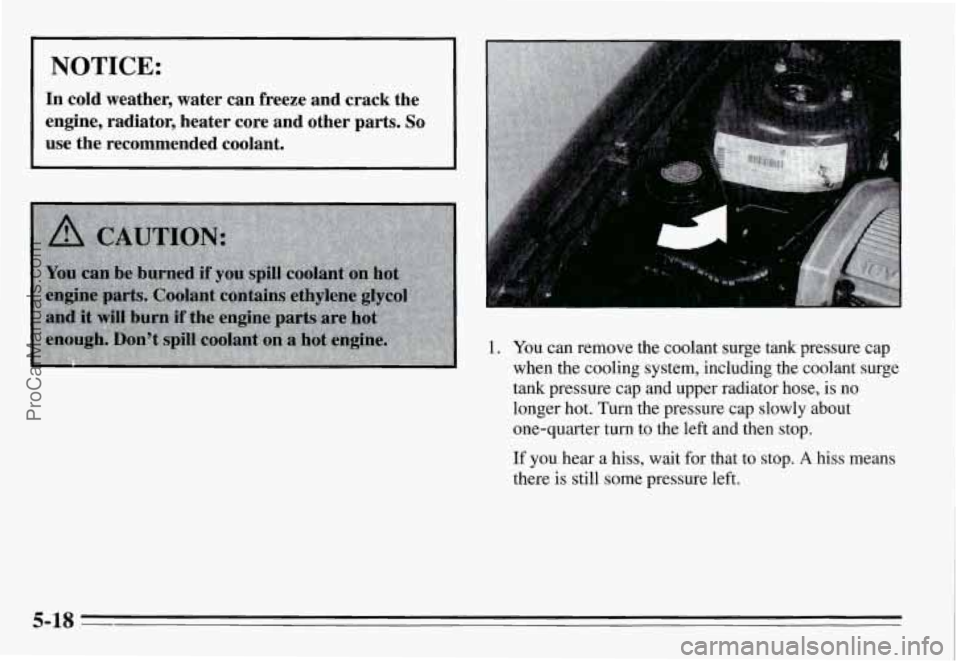
NOTICE:
In cold weather, water can freeze and crack the
engine, radiator, heater core and other parts.
So
use the recommended coolant.
1. You can remove the coolant surge tank pressure cap
when the cooling system, including the coolant surge
tank pressure cap and upper radiator hose, is no
longer hot. Turn the pressure cap slowly about
one-quarter turn to the left and then stop.
If you hear a hiss, wait for that to stop. A hiss means
there is still some pressure left.
5-18 -
ProCarManuals.com